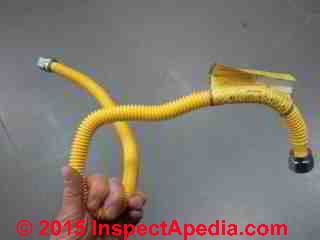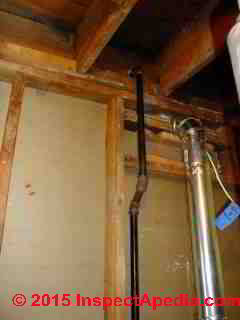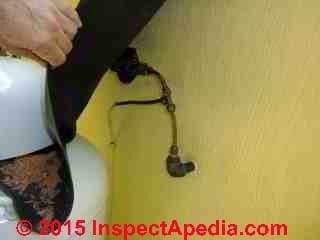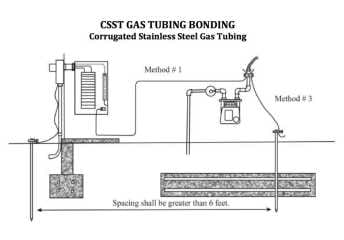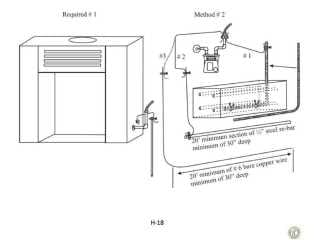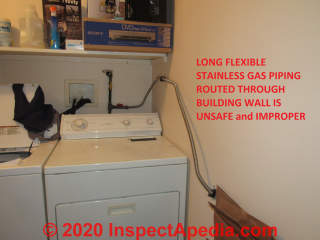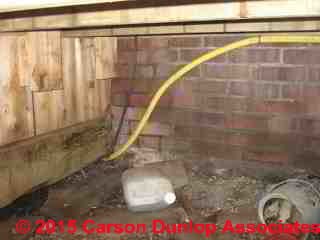 Corrugated Stainless Steel Tubing (CSST) Gas Piping
Corrugated Stainless Steel Tubing (CSST) Gas Piping
What is CSST, where is it used, how do manufacturers want it to be installed?
- POST a QUESTION or COMMENT about corrugated stainless steel tubing used for gas piping
Flexible gas piping CSST:
This article describes CSST: corrugated stainless steel tubing used for gas piping in buildings. Since 1990 CSST has been used within many buildings in both exposed and enclosed areas to install new gas system piping. The article discusses CSST uses, sources, installation specifications, and safety measures to protect the gas piping from damage by abrasion, puncture, lightning strikes or other hazards. Gas piping codes and industry sources of CSST are included.
Our page top photo, provided courtesy of Carson Dunlop Associates, a Toronto home inspection & education firm, illustrates an improper installation of standard yellow CSST gas piping - routed in ground contact in a wet area. Yellow "Standard" CSST gas pipin galso requires special electrical ground bonding to reduce risk of damage & leaks in areas of high lightning strike activity.
InspectAPedia tolerates no conflicts of interest. We have no relationship with advertisers, products, or services discussed at this website.
CSST Gas Piping: Corrugated Stainless Steel Tubing
Article Contents
- CSST GAS PIPING IDENTIFICATION
- CSST GAS PIPING SAFETY & PROTECTION
- CSST GAS PIPING CODES & STANDARDS
- CSST GAS PIPING MANUFACTURERS, SOURCES
What is CSST Gas Piping & How is it Identified in Buildings
CSST or Corrugated Stainless Steel Tubing is a flexible gas piping system that has been in use in the U.S. since 1990. In Japan the system has a decade more experience.
"Standard Yellow CSST" such as shown below (adapted from csstsafety.com) may appear in homes where gas piping was installed or modified since 1990.
Through csstsafety.com the National Association of State Fire Marshals and the CSST industry recommend that homes where gas piping has been installed or modified since 1990 be inspected for the presence of yellow CSST and that the electrical ground bonding in those homes be inspected.
[Click to enlarge any image]
Newer black or dark-jacketed CSST gas piping (shown below, adapted from GasTite's FlashShield CSST sales literature) currently sold by most manufacturers may not require special bonding.
Watch out: Let's avoid a point of confusion: CSST used as gas piping runs in buildings is not the same product as the flexible gas connector tubing (shown below) used to actually connect gas appliances to the gas supply system, and different installation and product protection measures are required.
CSST gas piping is used to route natural gas or LP gas supply through a building while the flexible gas tubing shown below is specifically designed for the connection of gas appliances to the gas piping system.
Where is CSST Gas Piping Being Installed?
Look for corrugated stainless steel tubing (CSST) used as gas piping in buildings constructed in the U.S. or Canada after 1990 and also look for it in older buildings where gas piping was newly installed or modified since 1990. CSST is also installed in other countries.
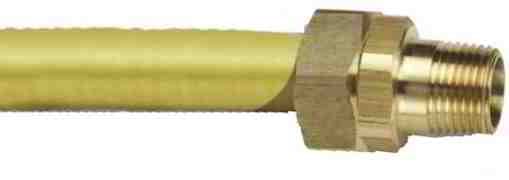 Standard "yellow" or newer black CSST can be recognized in (usually) long runs between the building gas source and its point of use at gas appliances.
Standard "yellow" or newer black CSST can be recognized in (usually) long runs between the building gas source and its point of use at gas appliances.
The gas appliance connector itself (shown in the photo just above) may be connected directly between the end of the CSST and the appliance, or the CSST may terminate or be mixed with black iron gas piping in the same building.
CSST gas piping is run both in exposed locations and through building cavities such as walls, ceilings or floors.
How many homes have CSST installed? We had trouble relating industry estimates with US Census data and U.S. Energy Information Agency data, but there is no doubt that the piping has been installed in many homes in Canada, the United States, and Japan.
According to the CSST Safety Website (below), corrugated stainless steel tubing is installed in about 500,000 new homes each year. As the U.S. Census Bureau and U.S. HUD February 2015 New Construction Data news release reports a seasonally adjusted annual rate of new construction in the U.S. of about one million homes, that suggests that half of all new homes are being built with CSST gas piping.
Or if we look at the February housing start data that means that almost 100% of new homes are using CSST gas piping - which sounds a bit dubious. In 2014 the U.S. EIA reported that 27% of all U.S. homes were supplied with natural gas and less than 1% with other gases.
Still, the system is in active use in the U.S. and Canada and continues in use in Japan.
Fire & Safety Measures to Protect CSST Gas Piping from Damage &Leaks
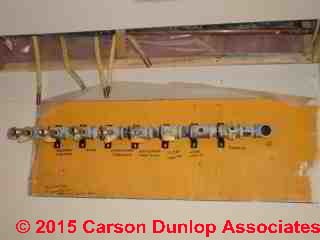
Reader Question: report of gas leak from punctured CSST Gas Piping
[At left, a new CSST gas piping installation, incomplete, is illustrated, courtesy of Carson Dunlop Associates, a Toronto home inspection, education & report writing tool company [ carsondunlop.com ].]
I'm a dwelling contractor in Wisconsin, I would like more information on Corrugated Stainless Steel Tubing (CSST) used for gas piping in buildings. It seems like manufacturers don't require it to be secured or strapped very much at all. 'm not sure what the codes say about that.
I've seen it snaked all over the place without support -- and here is a story of one consequence (quoting from an email to a manufacturer):
Email sent to ProFlex Technical Assistance
I wonder if you could give me an idea about support and protection requirements for CSST. I just came back from helping my Brother-in-Law with a few issues in his Condo in Boston -- he had a sprinkler pop over the winter, so a lot of the drywall had to be removed to dry things out.
When the restoration contractor removed one section of drywall, the smell of gas poured out.
CSST had been snaked through floor trusses and had looped up in one location, where a pneumatic nail from the wood flooring installation had punctured it.
Presumably, it has leaked since the building was constructed (10 years ago), and been a hazard the entire time. Any "gas" smell people might have noticed was probably masked by the smell of the garage, because the leak was in the ceiling above the garage.
Reading a few manufacturers' installation guides, there doesn't seem to be a requirement to SECURE the gas line at all -- it just has to be supported every 8' or so horizontally, right? In my Brother-in-Law's condo, the gas line was snaked all over and not really strapped anywhere, although it was protected by nail plates at stud and joist penetrations. Is this acceptable, according to your guidelines and any applicable codes?
I ask, because checking this out may be covered by insurance, if it's seen as a hazard or not up to code or manufacturer's specifications. Thanks, J.
The manufacturer's reply was essentially that the CSST needed to be kept 3" away from finished surfaces or protected by nail plates if also within 5" of some constraint (like a penetration through a framing member). Beyond that, it has an "escape" for nail penetrations.
This did not prevent the leak I described, as the CSST looped up and was hit by a pneumatically-driven flooring nail...
CSST seems like a great thing -- easy to install, etc. I wonder if you would do an article on it?
Thanks J.
Reply:
Our reply to reader J. begins immediately below
Lightning Strike Hazards and CSST Gas Piping Leaks
The history and field experience of CSST use in North America led to concerns about possible pitting, corrosion or perforation of the original yellow CSST gas piping in areas where lightning strikes were common. Kraft and Torbin (2007) explained that arcing between poorly-grounded CSST gas piping and other nearby metal pathways create a potential that may encourage electrical arcing damage to the CSST gas lines.
Such lightning-related electrical arcing can weaken or even perforate the gas piping leading to dangerous gas leaks.
The risk of arcing damage to CSST is increased in areas where lightning activity is greatest and where the CSST is not well bonded to a grounding system.
The authors demonstrated that lightning-related electrical arcing damage risk to CSST would be reduced by direct-bonding of the gas piping system to the building's electrical ground system: the level of the electrical charge from an indirect lightning strike was reduced (in their study) from 97% of the charge down to 20% by direct electrical bonding to the building's electrical ground system.
Their 2007 report concluded with a recommendation for direct ground bonding of CSST as a proposal to the National Fuel Gas Code. In 2009 the same authors reported that CSST could perform acceptably but made important and detailed recommendations for the ground bonding of CSST gas piping systems.
Goodson in a patent application (2009) also reported on the effectiveness of direct bonding of both yellow and black CSST gas piping to reduce the risk of damage from indirect lightning flashing. Goodson explained that CSST was generally not a good electrical ground, thus lending importance to the "direct bonding" discussion for this gas piping system. Stringfellow (2013) continued to report on electrically-induced gas distribution piping.
Currently (2015) the manufacturers have pretty much switched to an improved, more durable CSST gas piping whose design includes a protective outer jacket and for which extra manufacturer-specified ground bonding is not required. I think that only Ward continues to produce the yellow CSST for sale in the U.S.
According to Jim Narva, executive director of the National Association of State Fire Marshals, that association is focusing on informing homeowners of the need for retrofit ground bonding of older CSST installations.
... we are focused on a safety campaign to make homeowners aware of the need to bond yellow CSST. It is estimated to be in about 6-8 million homes where it was installed before bonding was a code requirement or manufacturer installation instruction
Between the early 1990’s when it was introduced in the US market and the mid 2000’s when the requirements came about is the target we are trying to reach and unfortunately no one knows where those 6-8 million homes are in the US. - private email, Narva to Friedman, 14 April 2015
Nail or Screw Puncture Risks with CSST Gas Piping
Above is an example of a traditional steel gas pipe routed through a wall cavity during building renovations of a New York Home.
OPINION: I agree that CSST needs to be protected from damage, including or perhaps in particular when it is run through building cavities where, hidden from view, it's otherwise too easy for a future building occupant or worker to shoot a nail or screw through the material.
One would think that excluding concerns for corrosion, similar worries apply to (and generally prohibit the use of) flexible copper tubing when used for gas piping: it is not routed within building cavities. Instead in those situations it's common to use steel piping for such gas lines.
Above you can see the traditional change from flexible copper tubing to steel piping when the gas piping system had to penetrate the building wall.
In the CSST installation example specifications listed below you'll see that the manufacturers typically require a number of installation details to assure safe reliable operation of the gas piping system, including nail plates, flexible corrugated steel armor in some locations, support, and other measures.
Some local jurisdictions further detail CSST gas piping installation specifications such as where and how it can be routed.
But CSST is indeed in widespread use as gas piping in both exposed and hidden locations. Here are some typical protective measures specified by CSST tubing manufacturers cited in the references above.
CSST Gas Piping Installation Code, Safety & Protection Features
- Code compliance: corrugated Stainless Steel Tubing should be installed to meet the installation requirements of sections G 2415 and Fuel Gas Code section 404.1. Additional local regulations may apply and may extend or supercede these model code guides.
- Watch out: your local building regulations are likely to be different from the example details given just below, and in in some jurisdictions CSST gas piping is prohibited:
- "Definitions, B. section 12 35 30-residential Casework." City Of Philadelphia (2011) in Philadelphia: OHCD/PHCD/RDFA Small Building Regulations (2011), Division 22 Plumbing, Quality Standards and Construction Procedures: - retrieved 14 Apr 2015, original source: http://www.phila.gov/ohcd/smallbldgspecs/smallbuildingspecsjune2011.pdf#page=231
Excerpt:
Corrugated Stainless Steel Tubing (CSST) is not permitted for gas piping.
- "Definitions, B. section 12 35 30-residential Casework." City Of Philadelphia (2011) in Philadelphia: OHCD/PHCD/RDFA Small Building Regulations (2011), Division 22 Plumbing, Quality Standards and Construction Procedures: - retrieved 14 Apr 2015, original source: http://www.phila.gov/ohcd/smallbldgspecs/smallbuildingspecsjune2011.pdf#page=231
- Direct Electrical Ground Bonding for CSST
of Standard Yellow CSST is required to the building's grounding conductor system using 6 AWG copper or larger is required for "standard yellow CSST" and must comply with the U.S. National Electrical Code (NEC), NFPA 70, and in Canada the Canadian Electrical Code (CSA-22.1 (CEC).
The industry safety association [csstsafety.com] notes that
Manufactures of black jacketed CSST products which have been tested and listed to ICC-ES LC 1024, “CSST Utilizing a Protective Jacket”, may not require or include in their instructions the additional direct-bonding step that is required with standard (yellow) CSST products. However local codes may be more restrictive and may differ from manufacturer's requirements. Local codes take precedence and must be adhered-to.
...
The 2015 edition of the National Fuel Gas Code, International Fuel Gas Code, and Uniform Plumbing Code limits the length of the bonding conductor to 75-ft.
When there are no local code requirements for the length of this conductor refer to the manufactures instructions or the NEC / CEC for guidance regarding the permissible length of the bonding conductor. - csssafety.com, Op. Cit. - CSST Electrical Ground System Bonding:
NFPA 54 National Fuel Gas Code. Sec 7.13.2 specifies the CSST bonding requirement. See our note earlier in this article about AmeriGas's comments about lightning protection for CSST gas piping. UL 467 pertains regarding bonding clamps. - Local building codes for CSST
are controlling and may differ from manufacturer's requirements. Local codes are governing and must be adhered to. - CSST Manufacturer's installation instructions:
The CSST manufacturers provide installation specifications for their products. Most model and enacted building codes require that just about any building component, equipment or device should be installed in accordance with the manufacturer's instructions. - CSST Pressure limitations:
some CSST gas piping systems put limits on the maximum gas pressure allowed: for example DiamondBack's installation manual specifies that
This system and related components must be used only with fuel gases, only where the operating gas pressure does not exceed 5 psi. (34.48 kPa). The maximum actual operating pressure including transients shall not in any case exceed 6.5 psi. - Op. Cit. - Professional installation:
CSST must be installed by a qualified professional and in accordance with the Manufacturer's Design and Installation (D&I) Guide, including bonding and grounding of the system - Protection in concrete:
Plastic conduit is required where CSST is run through concrete slabs & foundations - Protection of CSST from nails & screws
- Hardened nail plates are required where CSST passes through wood framing at distances less than 3" from the cavity surfaces
- Flexible steel conduit is required where CSST is routed in "floppy sections" through building cavities where it cannot be secured away from cavity surfaces. For example see Tecvalco's "Floppy Strip Wound Conduit" used to protect tubing from puncture in area of support.
- Support of CSST: some jurisdictions specify the maximum spacing of supports for CSST, typically in the 1-2 meter range depending on the pipe diameter and rigidity.
Local CSST Gas Piping Specifications Extending the Model Codes for Improved Safety
The following example is excerpted from a local Oklahoma Building Code for Rogers County, Appendix H, , Subsection "Policy for installation of Corrugated Stainless Steel Tubing (CSST)", in Appendix H-17General Information and Responsibilities for One & Two Family Residential Construction, - retrieved 14 April 2015, original source: http://www.rogerscounty.org/planning/zoning%5CAH.pdf -
[Click to enlarge any image]
- a) Corrugated Stainless Steel Tubing shall be permitted to be used as approved in the most recent codes that have been adopted. Current CSST approval codes are 2009 Fuel Gas Code Section 403.5.4 and 2009 International Residential Code G2414.5.3.
- b) Corrugated Stainless Steel Tubing shall be installed to meet the installation requirements of sections G 2415 and Fuel Gas Code section 404.1. The following installation requirements shall be used in addition to the requirements listed in the adopted codes.
- c) CSST shall not be allowed within the space between roof rafters.
- d) CSST shall not be allowed on the roof deck side of insulation installed between rafters.
- e) CSST shall not enter the attic by passing through the top plate of an exterior wall.
- f) CSST shall be installed with approved change in direction fittings per the manufactures instructions.
- g) CSST shall not be installed by lying on the top side of ceiling Joist.
- h) CSST shall be installed with a minimum of 6 inches separation from HVAC ductwork, Electrical wiring, Communication wiring, Metal electrical fixture boxes and their supports, or any other material that may create a path to ground.
- i) A minimum of 6 inches shall be maintained between the CSST and house wiring located within a wall cavity.
- j) CSST shall be bonded by a minimum bare number 6 solid copper wire. The bonding wire shall be attached to a lug added for that purpose in the main load center.
- k) CSST bonding wire shall be attached to a brass nut located on the CSST manifold, with the other end connecting to the lug added in the main load center.
- l) CSST bonding shall be installed by a licensed electrical contractor that is registered with Rogers County.
- m) CSST with damaged outer covering shall be replaced.
- n) CSST shall not be spliced.
- o) In Hybrid systems CSST shall not pass through walls.
- p) CSST used to repair an existing black pipe system shall be installed to meet the connector requirements as stated in Section 411 of the 2009 International Mechanical Code.
- q) When a CSST system is repaired or when equipment supplied by a CSST system is replaced the system shall be bonded to meet the current bonding requirements in place at the time of replacement.
CSST Gas Piping Codes, Specifications, Industry Trade Associations
- 2009 Fuel Gas Code Section 403.5.4
- 2009 International Residential Code G2414.5.3
- ANSI Z223.1 / NFPA 54 National Fuel Gas Code (2015)
- ANSI Z21.69/CSA 6.16: Connectors for Movable Gas Appliances
- CAN/CSA B149.1: Natural Gas and Propane Installation Codes.
- SA listed to ANSIZ21.75 /CSA 6.27 standard “Connectors for Outdoor Gas Appliances & Manufactured Homes” (file #204593)
- CSA listed to ANSIZ21.24 /CSA 6.10 standard “Connectors for Gas Appliances” (file #204593)
- CSST Safety Website: www.csstsafety.com, hosted by the National Association of Fire Marshals (NASFM), http://www.firemarshals.org/ This website discusses various aspects of CSST safety including lightning hazards, electrical ground bonding and grounding connections, and recommendations for consumers.
- DIRECT BONDING OF STANDARD (YELLOW) CSST, BONDING DETAILS [PDF], - retrieved 13 April 2015, original source: http://www.csstsafety.com/Images/CSST-Direct-Bonding-Tech-Bulletin.pdf
Excerpt:
Direct bonding is required for gas piping systems incorporating standard (yellow) or uncoated CSST whether or not the connected gas equipment is electrically powered.
This requirement is provided as part of the manufacturer's instruction for single-family and multi-family buildings and required by the 2009 and later editions of the National Fuel Gas Code, the International Fuel Gas Code and the Uniform Plumbing Code.
A person knowledgeable in electrical system design, the local electrical code and these requirements should specify the bonding for commercial applications. Standard CSST installed inside or attached to a building or structure shall be electrically continuous and direct bonded to the electrical ground system of the premises in which it is installed.
The gas piping system shall be considered to be direct-bonded when installed in accordance with [specifications in the original document - Ed.] - LIGHTNING SAFETY WARNING FROM MANUFACTURERS OF CORRUGATED STAINLESS STEEL TUBING (CSST) [PDF], - retrieved 13 April 2015, original source: http://www.csstsafety.com
- YELLOW CSST LIGHTNING SAFETY WARNING CAMPAIGN [PDF], consumer safety campaign managed by csstsafety.com and the National Association of State Fire Marshals to inspect homes built or where gas piping work was performed after 1990 for yellow CSST - Corrugated Stainless Steel Tubing used for gas piping. Where this piping is installed it should be inspected by a licensed electrician to assure that it is properly bonded to the building ground system. 13 April 2015, original source: http://www.csstsafety.com
- DIRECT BONDING OF STANDARD (YELLOW) CSST, BONDING DETAILS [PDF], - retrieved 13 April 2015, original source: http://www.csstsafety.com/Images/CSST-Direct-Bonding-Tech-Bulletin.pdf
- "Diamondback Flexible Gas Piping - Snake-It™ Design Guide and Installation Instruction Manual", Tecvalco Ltd., 3481 Stanley Ave. RR#1, Niagara Falls, ON L2E 6S4, Canada, - retrieved 13 April 2015, original source: http://www.tecvalco.com/sites/default/files/files/Tecvalco %20Diamondback/Diamondback_Design%20Guide% 20%26%20Installation%20Instruction%20Manual.pdf
- International Fuel Gas Code
- "Lightning Safety Warnings from Manufacturers of Corrugated Stainless Steel Tubing (CSST)", Amerigas Corporation, Valley Forge PA, USA, (2013), Tel: 1-800-263-7442, -
retrieved 13 April 2015, original source: http://www.amerigas.com/pdfs/CSST-Lightning-Safety-Warning.pdf -
Excerpt:
Lightning strikes at or near properties equipped with CSST have occasionally been reported to result in fires at those properties. It is believed that nearby lightning strikes can cause electrically conductive components, like CSST, to become energized, which can result in pitting or other damage to the CSST and, in turn, could cause an explosion and/or fire.
If you determine that you have CSST at your home or business, CSST manufacturers strongly encourage you to make sure your CSST system is properly bonded and grounded in order to reduce the risk of damage from a lightning strike.
The manufacturers recommend contacting a licensed electrician to perform such bonding and grounding work.
States with significant lightning risk include, but are not limited to: Alabama, Arkansas, Florida, Georgia, Illinois, Indiana, Iowa, Kentucky, Louisiana, Maryland, Michigan, Mississippi, Missouri, New Mexico, North Carolina, Ohio, Oklahoma, Pennsylvania, South Carolina, Tennessee, Texas, Virginia and West Virginia, as based on data collected by the National Lightning Detection Network and compiled in the Cloud-to-Ground Flashes by State 1997 to 2012: www.lightningsafety.noaa.gov/stats/97-12Flash_DensitybyState.pdf For more information on CSST safety, please visit www.csstsafety.com
For more information about the various CSST products manufactured by CSST manufacturers, please visit their individual websites, a non-exclusive list of which is below. - Philadelphia building codes: "Definitions, B. section 12 35 30-residential Casework." City Of Philadelphia (2011) in Philadelphia: OHCD/PHCD/RDFA Small Building Regulations (2011), Division 22 Plumbing, Quality Standards and COnstruction Procedures: - retrieved 14 Apr 2015, original source: http://www.phila.gov/ohcd/smallbldgspecs/smallbuildingspecsjune2011.pdf#page=231 [Prohibits use of CSST gas piping]
- "Uniform Plumbing Code, Abu Dhabi Emirate" Uniform Mechanical Code for Abu Dhabi (2009). This code requires bonding for CSST and includes detailed specifications for installation of CSST including the installation and spacing of supports (ranging from 1.2 to 2.4m depending on pipe diameter)
CSST Gas Piping Safety Research, Patents, Studies
- Durham, Robert A., and Marcus O. Durham. "Does Corrugated Tubing Lightning Catastrophic Failure?." Industry Applications, IEEE Transactions on 48, no. 4 (2012): 1243-1250.
Abstract
In conducting analysis of systems that have failed as a result of lightning and transients, the authors have observed repeated incidences associated with corrugated flexible tubing (CFT). Corrugated stainless-steel tubing is one of a group of flexible pipes used for low-pressure gas.
This tubing is increasingly used not only in processes but also in laboratories, warehouses, and office facilities for distribution of heating gas. These products were designed with mechanical properties in mind.
The design does not directly consider electrical characteristics; however, since these piping systems are constructed of conductive metals, they will have electrical properties.
Despite the observed tendency of this piping to fail during lighting and transient events, there has been no coherent hypothesis for the phenomenon of CFT failure due to lightning. This paper will address the electromagnetic response of these tubing systems.
Ten electrical properties are correlated to the impact of lightning and transients on materials such as corrugated tubing. - Durham, M. O., and R. A. Durham. "Lightning dangers on corrugated tubing carrying hydrocarbons." In Petroleum and Chemical Industry Conference (PCIC), 2010 Record of Conference Papers Industry Applications Society 57th Annual, pp. 1-9. IEEE, 2010.
- "Industry PR Efforts Prompt Media Coverage of CSST / Gas-related Lightning Fires", Flash Notes, The Lightning Protection Institute, 25475 Magnolia Dr., POB 99, Maryville MO 64468, Tel: 660-582-0429, Email: LPI@lightning.org, Website: Lightning.org (Summer/Fall 2007), - retrieved 14 April 2015, original source:http://www.lightning.org/wp-content/uploads/2012/10/Flash_Notes_Summer-Fall_07.pdf
This article cites a 2007 press release distributed "in conjunction with the 2007 NFPA World Safety Conference on June 4 2007". That press release was titled "Lightning Fires Linked to Problem Gas Tubing", 6/4/2007
Quoting:
A class action lawsuit against four manufacturers of a relatively new type of fuel gas piping has identified the installation of a lightning protection system as a remedy for the fire risk associated with CSST (corrugated stainless steel tubing) gas piping systems. CSST is a type of flexible piping that has been widely used in homes and commercial applications in recent years.
Unlike traditional, heavy-walled gas pipes, CSST is extremely thin and therefore susceptible to damage from lightning. Lightning traveling on the CSST can burn holes in the tubing and allow gas leakage and fire. In worse [sic] case scenarios, such leaks have led to catastrophic gas explosions.
The CSST has been found to be susceptible to damage from direct and even indirect nearby lighting strikes.
CSST has been widely used in recent years because it is easy to install. According to the National Fire Protection Association (NFPA) however, no tests on the effects of lightning on CSST were conducted prior to its approval for use. One CSST manufacturer has acknowledged that the installation of a lightning protection system addresses the hazard associated with CSST, yet homes with CSST are rarely equipped with lightning protection systems. ...
...
"Lightning does not have to strike a building directly in order for the CSST to be affected," explains Guy Maxwell, president of the Lightning Safety Alliance. "The reports of CSST related fires that I have seen involved strikes that were near the structure."
...
In March 2007, the four defendants in the Class Action suit filed in the Circuit Court of County Arkansas reached a Settlement. Under the guidelines of the settlement, owners of structures in the U.S., in which CSST was installed prior to September 2006, can obtain vouchers to defray the cost of mitigating the CSST hazard.
Remedies identified by the settling parties include installing a lightning protection system and/or making bonding and grounding connections to certain systems in a structure.
...
The deadline to enter a claim under the CSST Settlement is September 5, 2007. For more information call 1-800-420-2916 or visit the website at www [dot] csstsettlement [DOT] .com.
NOTE: the above website is no longer functional. Do not bother trying it as it's simply an advertising site. Editor, 4/14/2015. - Kraft, Brian, and Robert Torbin. "Effectiveness of Direct Bonding of Gas Piping in Mitigating Damage from an Indirect Lightning Flash." (2007).
- Kraft, Brian, P.E., & Torbin, Robert, P.E., "Evaluation of CSST Gas Piping Subjected to Electrical Insult." Rising Tide Consulting, L. L. C., and L. L. C. Cutting Edge Solutions. (2009).
Excerpts from the article's Executive Summary:
Recent events have shown the proclivity of corrugated stainless steel tubing (CSST) to become physically damaged (through electrical arcing) when installed in close proximity to other metallic systems that are simultaneously energized by a lightning strike but not equally bonded to the grounding electrode system.
This has raised concerns within the electrical community about the general capability of CSST to withstand other electrical insults associated with the “normal” use of electricity. This report summarizes the engineering analysis performed to address these concerns regarding the performance of CSST under electrical insult.
Considering current installation practices and code requirements for residential construction, electrical service and fuel gas piping systems, the most probable (and severe) electrical insults were determined to be fault current and indirect lightning strikes. The damage modes associated with CSST and these insults were identified as: resistance heating in conductors, resistance heating in connectors, mechanical damage in connections, and arcing between conductors.
Excerpts from the article's Conclusions:
It was determined that the primary electrical insults that required evaluation were the application of a fault current to the gas piping and the application of high voltages and currents due to indirect lightning strikes.
The ability of the material, (tubing, fittings and electrical connectors) to function safely and to resist damage from associated currents, voltages, and arcing was examined.
Based on this evaluation and testing, the CSST materials and product investigated were found to be capable of performing acceptably well when exposed to anticipated electrical insults that may occur within a residential or light-commercial building.
The article continues to list of important recommendations for direct bonding of the CSST tubing to reduce arcing damage. - Rousseau, Alain, and Mitchell Guthrie. "Direct Lightning Withstand of Corrugated Stainless Steel Tubing for Gas.", 2012 International Conference on Lightning Protection (ILCP), Vienna, Austria. - retrieved 13 April 2015, original source: http://seftim.clic-droit-tech.com/publications/ICLP/ICLP_2012_CSSTinvestigations.pdf
Abstract
Corrugated stainless steel tubing (CSST) is used in many countries throughout the world as a practical way to distribute gas within houses and other installations. CSST has become very popular in some countries as it is a very thin and thus flexible tube that allows for easy installation in crawl spaces, inside walls, and in the attic.
A link between lightning activity and fires involving CSST piping has been reported in the United States as early as 2003.
Damages documented to CSST generally result in one or more holes in the wall of the pipe leading to a release of gas into the structure with no fire to fire with minimal damage and in some cases complete destruction of the structure. Many experts have studied this subject and many scenarios have been established to explain the failure modes.
A few reports exist and are summarized in the paper. This paper will then mainly concentrate on case studies and on test results for one scenario that has been almost ignored: partial lightning current flowing - Stringfellow, Michael F. "Causes of residential lightning fires: Electrical arcs are at the root." Industry Applications Magazine, IEEE 19, no. 3 (2013): 60-66.
Abstract:
This article presents evidence that a major cause of residential lightning fires is electrical arc-fault current. Such arc-fault currents are a common result of both direct and indirect lightning strikes. These faults result from lightning overvoltage damage to the insulation of electricity supply conductors and appliances.
Many of these overvoltages appear to be caused by indirect lightning strikes, and a small fraction of these events also result in damage to fuel gas systems, especially thin, metallic, flexible gas lines. Fuel gas leaks resulting from this electrical damage may contribute to the fire hazard.
The absence of any lightning protection on residences with exposed metallic roof penetrations is considered a major factor.
CSST Patents Aiding in Finding the History of CSST Gas Piping Usage
- Albino, Mark. "Corrugated tubing fitting." U.S. Patent 5,799,989, issued September 1, 1998.
- Albino, Mark, and Edwin E. Pike. "Preassembled fitting for use with corrugated tubing." U.S. Patent 6,079,749, issued June 27, 2000.
- Albino, Mark. "Underground piping system." U.S. Patent 6,315,003, issued November 13, 2001.
- Duquette, Scott, and Brian Coppola. "Sealing devices and methods of installing energy dissipative tubing." U.S. Patent 8,399,767, issued March 19, 2013.
ABSTRACT
Sealing devices are provided along with methods of installing energy dissipating tubing. An aspect of the invention provides a sealing device for connecting an energy dissipative tube having a length of tubing, a first resin layer surrounding the outside of the tubing, a conductive layer adjacent to the outside of the first resin layer, and a second resin layer surrounding the conductive layer and the first resin layer. The sealing device includes one or more penetrating members configured to penetrate the second resin layer and establish electrical continuity with the conductive layer. - Goodson, Mark E. "Method of preventing electrically induced fires in gas tubing." U.S. Patent 7,562,448, issued July 21, 2009.
- Goodson, Mark E. "Device for Preventing Electrically Induced Fires in Gas Tubing." U.S. Patent Application 12/971,802, filed December 17, 2010.
- Goodson, Mark E. "Leak prevention method for gas lines." U.S. Patent 8,251,085, issued August 28, 2012.
- Lininger, Thomas B., Steven M. Powell, and Nicholas Novak. "Secondary contained csst pipe and fitting assembly." U.S. Patent Application 12/064,539, filed August 22, 2006.
- Mau, Andrew E. "Self-flaring, split bushing pipe fitting and hose assemblies employing same." U.S. Patent 6,173,995, issued January 16, 2001.
- Treichel, Steven A. "Fitting for use with corrugated tubing." U.S. Patent 6,276,728, issued August 21, 2001.
- Treichel, Steven A. "Sealed fitting for use with corrugated tubing." U.S. Patent 6,695,353, issued February 24, 2004.
Sources of CSST Corrugated Stainless Steel Tubing, Plastic Gas Piping, Underground Gas Piping, & Installation Manuals
- GasTite, Inc., (manufacturer of FlashShield™ system Corrugated Stainless Steel Tubing (CSST). Gastite Division
1116 Vaughn Parkway
Portland, TN 37148
Telephone 800-662-0208
Website: www.gastite.com, Email: gastite@gastite.com
[This is a metallically-shielded 0.010 wall thickness Annealed 304 stainless steel CSST system that meets LC1024 & LC1027. No additional manufacturer-bonding is required. black tubing product promising superior lightning protection.].
Quoting:
FlashShield™ Corrugated Stainless Steel Tubing (CSST) supplies natural gas or LP gas to appliances. FlashShield is a reliable, lightning-resistant system that can be installed in all modes of construction. Flexibility and no additional bonding means quick and easy installations: FlashShield® installs 30-70% faster than traditional piping methods.
Tubing material: ASTM A240 Type 304 321 Stainless Steel
Tubing jacket material: UV resistant Polyethylene complying with requirements of ASTM E84 Index for Flame and Smoke. - GAS SUPPLY INSTALLATION BLUE BOOK - NY [PDF] (2015) National Grid
- GASTITE FLASHSHIELD PIPING MANUAL [PDF] Gastite underground gas piping: Website: www.gastite.com Tel: 800-662-0208 Email: gastite@gastite.com
- HOME-FLEX FLEXIBLE CSST GAS PIPE MANUAL [PDF] Home-Flex underground gas piping Website: homeflex.com Tel: 1-661-257-3923
- Metal-Fab, Inc. (manufacturer of Diamondback CSST gas piping)
Website: www.mtlfab.com - Omegaflex, Inc. (manufacturer of TracPipe and CounterStrike CSST gas piping), Omega Flex Incorporated, 451 Creamery Way, Exton, PA 1 Tel: 610.524.7272 Toll Free: 800.355.1039. [No additional manufacturer bonding requirements].
Website: www.tracpipe.com
Quoting:
TracPipe® CounterStrike® is a patented CSST innovation based on our existing TracPipe® CounterStrike® CSST product, but that is engineered to significantly decrease the potential for lightning induced damage to fuel gas piping systems. TracPipe® CounterStrike® has been designed with a proprietary jacket material in place of the standard yellow jacket.
This black jacket has energy dissipating properties that will help protect the TracPipe® CounterStrike® stainless steel pressure liner as well as other fuel gas system components if the TracPipe® CounterStrike® becomes energized due to lightning. - HomeFlex INSTALLATION MANUAL [PDF] Valencia Pipe Co., - original source: http://homeflex.com/downloads/HOME-FLEX_Installation_Manual.pdf
- PSE&G, GAS APPLIANCE and GAS PIPING [PDF], (2021), PSE&G Construction, New Jersey, USA, TEl: 800-722-0256, retrieved 2023/07/07, original source: nj.pseg.com/-/media/pseg/global/gathercontentdocuments/7-2-1upgradesandnewinstallationsnew/gas_appliances_gas_piping.ashx
- PSE&G, GAS APPLIANCE SAFETY [PDF] PSE&G Construction, New Jersey, USA, retrieved 2023/07/07, original source nj.pseg.com/safetyandreliability/gassafety/gasappliances
- Parker Hannifin, Corp. (manufacturer of Parflex CSST gas piping) Website: www.parker.com
- Pro-Flex, LLC (manufacturer of ProFlex CSST Flexible Gas Piping) Website: www.proflexcsst.com
- Titeflex Corporation (manufacturer of the Gastite System CSST Corrugated Stainless Steel Tubing) Website: www.gastite.com/index.html=
- TracPipe, CANADIAN FLEXIBLE GAS PIPING DESIGN GUIDE & INSTALLATION INSTRUCTIONS [PDF] Original source: https://tracpipe.ca/wp-content/uploads/FGP_001_DI_Guide.pdf
- TracPipe FLEXIBLE GAS PIPING DESIGN GUIDE and INSTALLATION INSTRUCTIONS [PDF] (2016) TracPipe, CounterStrike, from Omega Flex, Inc.,
Excerpts:
The TracPipe® CounterStrike® CSST (corrugated stainless steel tubing) flexible gas piping material must only be installed by a qualified person who has been sucessfully trained through the The TracPipe® CounterStrike® gas piping installation program.
...
The jacket on the The TracPipe® CounterStrike® CSST shall not be removed, altered or modified in any fashion including full or partial painting or coating of the surface and the mounting of adhesively attached plastic or paper labels without the express consent of OmegaFlex®. - Ward Manufacturing, Inc. (manufacturer of Wardflex and Wardflex II CSST gas piping) Website: www.wardflex.com/index.htm
Reader Comments, Questions & Answers About The Article Above
Below you will find questions and answers previously posted on this page at its page bottom reader comment box.
Reader Q&A - also see RECOMMENDED ARTICLES & FAQs
On 2022-11-18 by InspectApedia (Editor) (mod) - Can csst be used outside. Can csst be supported on the bottom of floor joists in basement.
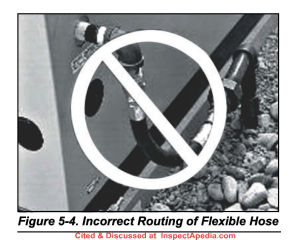 @Dennis,
@Dennis,
As Mark Cramer says ... it depends.
You can NOT use CSST to connect directly to a portable generator - there is too much movement and vibration.
The photo, from a Generac generator manual provided in our articles on that topic, shows a prohibited flexible connector (that example isn't CSST) at a generator..
We have not found "CSST" mentioned at all in the backup electrical generator installation manuals that we reviewed.
PLEASE SEE this Q&A and our detailed reply now at
GAS SUPPLY for ELECTRIC GENERATORS
Thank you for a helpful question.
On 2022-11-17 by Dennis
Can you use CSST to supply a standby generator as long as it is a dedicated line and has excess supply capacity for the generator.
On 2021-10-05 by inspectapedia.com.moderator (mod)
@Earl D.,
Yes there are version of CSST sold for outdoor use.
Yes CSST can be run under a floor
BUT in both cases the CSST product selected must be the right one for the installation and you must follow the manufacturer's instructions.
Details:
Unlike traditional, heavy-walled gas pipes, CSST is extremely thin and therefore susceptible to damage and contact with sharp objects, dirt and debris, or harmful substances is to be avoided.
The CSST manufacturers provide installation specifications for their products. Most model and enacted building codes require that just about any building component, equipment or device should be installed in accordance with the manufacturer's instructions.
CSST must be installed by a qualified professional and in accordance with the Manufacturer's Design and Installation (D&I) Guide, including bonding and grounding of the system.
Both of your questions can be answered by following manufacturer's installation directions and by discussing with a qualified professional.
Bottom line: CSST flexible gas piping is indeed sold in versions that are rated for outdoor use.
Of course there are protection, routing, electrical grounding and other requirements for such piping to be safe and functional.
Be sure to read those and the applicable standards that are given in the article above on this page as well as manufacturers own installation instructions.
On 2021-10-05 by Earl D.
Can csst be used outside. Can csst be supported on the bottom of floor joists in basement.
Question: is this gas piping using flexible lines safe and proper?
I inspected a bi-level yesterday and came across the attached picture.
Picture is from the lower level laundry / boiler room.
I have not seen gas piping installed in this method.
There was an oven installed at the adjacent kitchen.
Per client, the home was filed as a mother daughter home but does not have approval (C of O) for gas range installation.
Other than the legal aspect. I am concerned that it may be a safety issue.
Please advise - DovBer Kahn 2020/04/20
- Dov Ber Kahn, a home inspector in Rockland County, NY has contributed photographs of various building features. Mr. Kahn is a licensed home inspector in New York and New Jersey, and can be reached at Website: Kahnbhomeinspectors, Tel: 845-445-8234, Email: kdovber@googlemail.com
Moderator reply:
Flexible gas piping is listed for appliance connections, but is not permitted to be routed through hidden spaces such as a wall, ceiling, or floor.
Watch out: The concern is for mechanical damage or puncture and a subsequent gas leak, asphyxiation or explosion death of occupants.
The photo suggests installation by an un-qualified installer.
See details at FLEXIBLE GAS CONNECTOR INSTALL
On 2020-05-22 - by (mod) - How can the CSST be bonded when it’s not near my unit or the electric panel?
Joe
Forgive my griping but this sounds like a possible example of the OPM problem. Someone, probably a home inspector, is spending your money to reduce their risk - it's a great deal for them as your money is "free" to them.
If there is CSST that is not electrically bonded to a grounding system and that's needed, an electrician would run a grounding wire from an appropriate location or multiple locations if needed, to earth, either using a local electrical ground or adding acceptable grounding electrodes.
If I were seller of such a property and if I were willing to make such an allowance to a buyer, I'd ask my attorney to offer a reasonable contribution to the cost of the job. $250. My OPINION is that for such items an allowance, rathe rather than doing the work, is a better deal for both buyer and seller.
For the seller, you avoid getting dragged into an abyss of unknown hassle and expanding costs.
For the buyer, she can be certain that the work is both done properly AND that the work was performed by someone who is accountable to her. Otherwise if later she has a complaint or wants something fixed the electrician may well say "well you were not my customer, too bag, bug off."
The OPM problem is explained at OTHER PEOPLE's MONEY
On 2020-05-22 by Jon Raleigh
I have a townhome built in 2006. I am selling it and buyer wants CSST bonded. It has 6 units. The gas supply is on the east end and the electric panel is on the west end. My unit is on the middle.
How can the CSST be bonded when it’s not near my unit or the electric panel?
On 2019-12-11 - by (mod) -
Dennis
CSST is code-approved in Canada - though must be installed by a qualified installer. You'll want to find something like "Listings: CSA 256532 / IAPMO 7660" regardless of whether the CSST was made in the U.S. or Canada
Look for a CSA code stamp or label on the product.
Examples include
HomeFlex INSTALLATION MANUAL [PDF] Valencia Pipe Co.,
- original source: http://homeflex.com/downloads/HOME-FLEX_Installation_Manual.pdf
TracPipe, CANADIAN FLEXIBLE GAS PIPING DESIGN GUIDE & INSTALLATION INSTRUCTIONS [PDF]
Original source: https://tracpipe.ca/wp-content/uploads/FGP_001_DI_Guide.pdf
Also see
CAN-CGA-B149.1 Natural gas installation book used in Canada.
CAN-CGA-B149.2 Propane gas installation book used in Canada.
On 2019-12-10 by Dennis
Can US code flexible stainless steel tubing be used in canada
On 2018-06-24 - by (mod) -
For an isolated leak replace just the leaky section.
If conditions such as overheating have damaged the entire piping then ... ick ... wider replacement is probably needed.
On 2018-06-24 by Burt
what is the best practice for fixing a punctured CSST line? Can plumber split in a joint connector, or does the whole line need to be replaced?
On 2018-04-09 - by (mod) -
'm not aware of any cast iron gas piping in modern use.
On 2018-04-09 by Russell
Is cast legal for commercial application in Illinois?
On 2018-04-09 by Russell
@Mark,
Yes and fastened to wall has quick coupler connection
On 2015-11-04 - by (mod) -
Mark I don't know what that is.
When you cannot use a labelled, listed flexible connector use the type of iron pipe and fittings that your local code officials will insist upon.
Watch out:
1. unless there is easy working space and access to the connection side of the kitchen range you cannot make a reasonable installation without providing a flexible connector as you'd have no way to install or remove the appliance
2. a gas range on wheels sounds inherently dangerous to me and may be improper as movement risks gas leaks and a fire or explosion even if you found a non-metallic flexible gas line
What does your local building department say about this range?
On 2015-11-03 by Mark
Is there such a thing as a 1" gas non corrugated flex connector tube for a commercial kitchen range on wheels that is code compliant? Something that would not fatigue like the standard corrugated gas flex tube would. They want to be able to easily move the range for cleaning. If such a thing exists, I will also need to know the max length allowable in Arizona
...
Continue reading at GAS PIPING, VALVES, CONTROLS - topic home, or select a topic from the closely-related articles below, or see the complete ARTICLE INDEX.
Or see these
Recommended Articles
- ELECTRICAL GROUND SYSTEM INSPECTION
- GAS COOKTOP INSTALLATION
- GAS PIPING, VALVES, CONTROLS - home
- GAS METER CODES & CLEARANCE DISTANCES
- GAS REGULATORS & APPLIANCE / HEATER CONTROLS
- GAS REGULATORS for LP TANKS
- GAS SUPPLY for ELECTRIC GENERATORS
Suggested citation for this web page
GAS PIPING, FLEXIBLE CSST at InspectApedia.com - online encyclopedia of building & environmental inspection, testing, diagnosis, repair, & problem prevention advice.
Or see this
INDEX to RELATED ARTICLES: ARTICLE INDEX to GAS APPLIANCES, PIPING, CONTROLS
Or use the SEARCH BOX found below to Ask a Question or Search InspectApedia
Ask a Question or Search InspectApedia
Try the search box just below, or if you prefer, post a question or comment in the Comments box below and we will respond promptly.
Search the InspectApedia website
Note: appearance of your Comment below may be delayed: if your comment contains an image, photograph, web link, or text that looks to the software as if it might be a web link, your posting will appear after it has been approved by a moderator. Apologies for the delay.
Only one image can be added per comment but you can post as many comments, and therefore images, as you like.
You will not receive a notification when a response to your question has been posted.
Please bookmark this page to make it easy for you to check back for our response.
Our Comment Box is provided by Countable Web Productions countable.ca
Citations & References
In addition to any citations in the article above, a full list is available on request.
- In addition to citations & references found in this article, see the research citations given at the end of the related articles found at our suggested
CONTINUE READING or RECOMMENDED ARTICLES.
- Carson, Dunlop & Associates Ltd., 120 Carlton Street Suite 407, Toronto ON M5A 4K2. Tel: (416) 964-9415 1-800-268-7070 Email: info@carsondunlop.com. Alan Carson is a past president of ASHI, the American Society of Home Inspectors.
Thanks to Alan Carson and Bob Dunlop, for permission for InspectAPedia to use text excerpts from The HOME REFERENCE BOOK - the Encyclopedia of Homes and to use illustrations from The ILLUSTRATED HOME .
Carson Dunlop Associates provides extensive home inspection education and report writing material. In gratitude we provide links to tsome Carson Dunlop Associates products and services.




